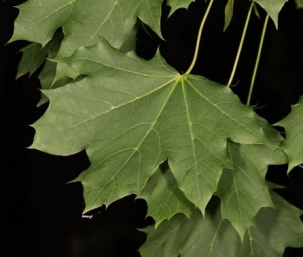The Norway maple (Acer platanoides; l’Érable de Norvège) is a Eurasian deciduous tree that was commonly planted when it was first introduced to North America as an ornamental. It has been naturalized in the provinces of Quebec, Ontario, and British Columbia (USDA Plants Database, n.d.).
The tall tree is easily recognizable due to its large crown and size, along with its dark green wide leaves. The leaves usually have five to seven sharply pointed lobes. If observed closely, the leaf stem has a milky sap, which other maples do not. In the fall, the leaves turn yellow very late in the season.
While the Norway maple grows well in urban areas because it has is relatively easy to maintain and resistant to insects and many types of fungi, its ability to spread and grow where is it not native leads to it being listed as an invasive species, a threat to the native species such as the sugar maple (Tree Canada, n.d; Ontario Invasive Plant Council, 2020). The successful colonization of the Norway maple could be due to the abundance of Quebec mycorrhizal fungi and bacteria symbiotically associated with it, which could enhance the its nutrient absorption, in contrast with the sugar maple (DeBellis, et al. 2019; Fonds de recherche du Québec, 2020.) Moreover, once mature, the shade of the Norway maple restricts the ability of seedlings and shrubs to grow underneath it.
As of 2023, Norway maples are the most common trees on the Loyola campus and the second most common among the public trees of Montreal (Quebec Centre for Biodiversity Science 2023).
References
- DeBellis T,et al. (2019). Shared mycorrhizae but distinct communities of other root-associated microbes on co-occurring native and invasive maples. PeerJ 7:e7295 https://doi.org/10.7717/peerj.7295
- Fonds de recherche du Québec. (2020). Microbes to fight the invasion of the Norway maple - Fonds de recherche du Québec - FRQ. Fonds de recherche du Québec. Retrieved January 26, 2023, from https://frq.gouv.qc.ca/en/story-and-report/microbes-to-fight-the-invasion-of-the-norway-maple/
- Ontario Invasive Plant Council. (2020). Best Management Practices in Ontario Norway Maple (Acer platanoides). Ontario Invasive Plant Council. Retrieved January 26, 2023, from https://www.ontarioinvasiveplants.ca/invasive-plants/species/norway-maple/
- Tree Canada, Arbres Canada. (n.d.). Tree Killers: Norway Maple. Tree Canada. Retrieved January 26, 2023, from https://treecanada.ca/resources/tree-killers/norway-maple/
- USDA Plants Database (By USDA NRCS National Plant Data Team.). (n.d.). Acer platanoides L. Norway maple. United States Department of Agriculture Natural Resources Conservation Service. Retrieved January 26, 2023, from https://plants.usda.gov/home/plantProfile?symbol=ACPL


 Acer platanoides, Norway maple leaves
Acer platanoides, Norway maple leaves